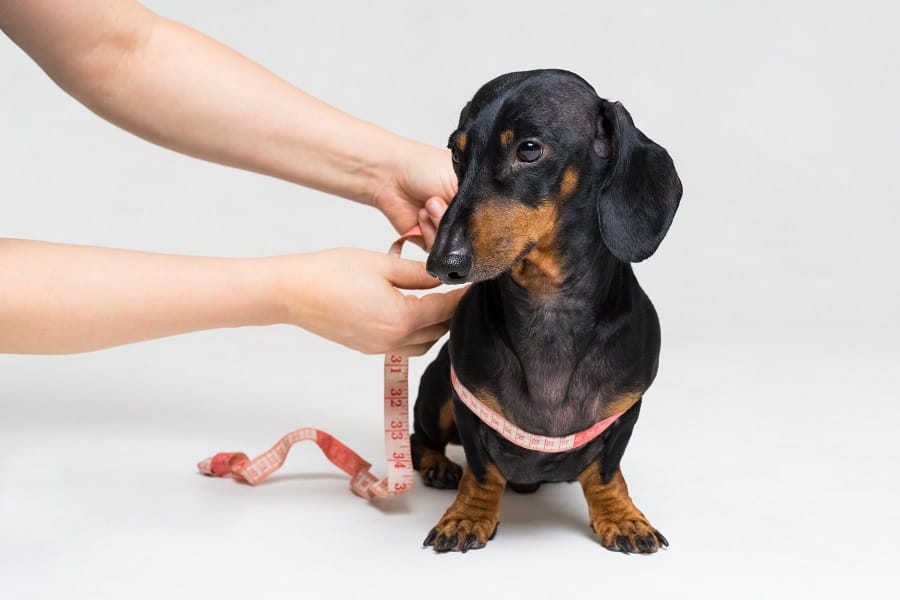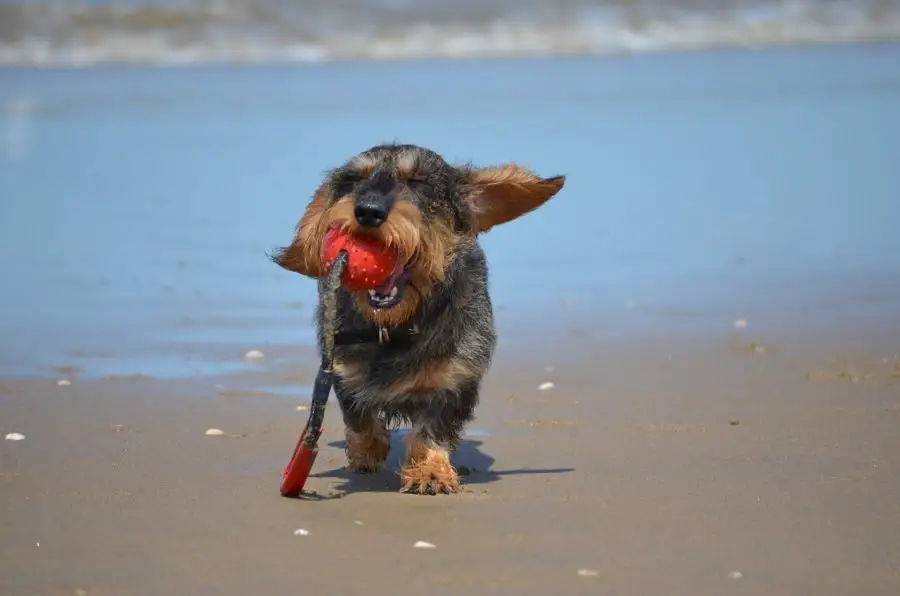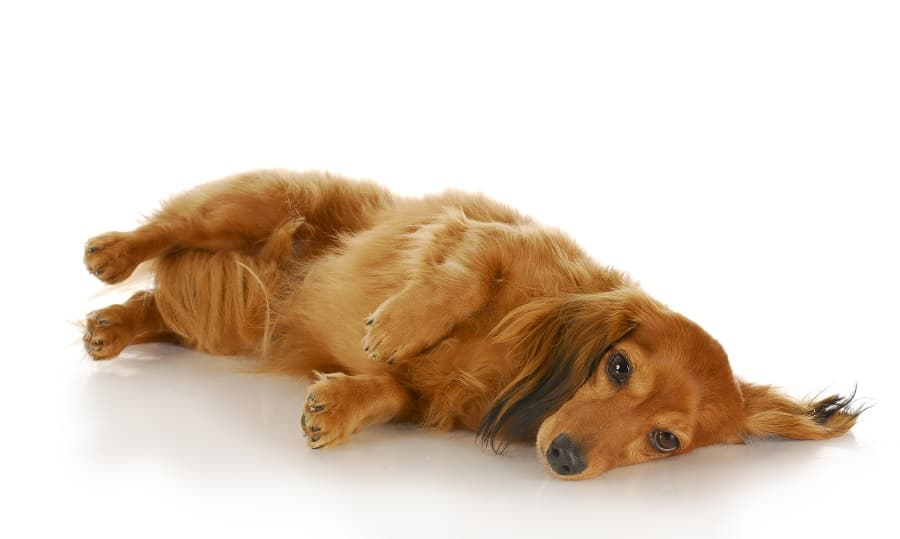If we could keep our dachshunds as young and innocent as they are as puppies, many of us would choose to do so, but it’s inevitable that they will grow and develop into mature and spirited dogs in the months and years to come.
If you have one of these intelligent, devoted dogs, you may be asking, When will my Dachshund be fully grown?
What Should I Know about or Look for in My Dachshund to Determine If It Has Fully Grown?

Dachshunds are bred and shown in two sizes – miniature and standard – each with their own weight and height distributions.
Among these breeds, there are several varieties, ranging from wirehaired to longhaired and even smooth, and each variety has its own individual height and weight limits.
With all these variables it can be difficult for new dog owners to determine if their Dachshund has reached maturity.
Beyond breed, height and weight, you may also have to consider your Dachshunds behavior to determine its maturity level.
Most dogs go through three stages of development as they grow old – puppy, adolescent, and adult – each with their own individual behavioral traits which help accurately place your puppy into one of these stages.
You should evaluate all of these concepts before you begin to determine if your Dachshund is finished growing.
Dachshund Breeds
As we stated before, Dachshunds come in two breeds, the miniature and the standard.
Miniature Dachshunds are typically much smaller than their standard counterparts at 5 to 6 inches at the shoulder and 11 pounds or less.
The standard can easily tower over these miniatures at 8 to 9 inches and 16 to 32 pounds in adulthood.
There is some variation between the varieties of Dachshund, though these weight and height differences are as yet unclassified by major dog breeders.
Dachshund Weight And Body Features

Just like humans, dogs also have growth plates which close once they reach a certain age. Once these growth plates are fully closed, your dog will be fully grown.
For Dachshunds, this usually occurs at around 6 to 8 months of age. By this point, you will have a general idea of how large your dog will ultimately be.
Many dog breeds will keep their “juvenile” appearance for the first few years of life, but they will no longer grow.
Although your Dachshund may still look like a puppy – a coat of soft fur, round facial features, and a narrow chest – your dog will no longer be growing after about 2 years.
Another great way to determine if what you see is your Dachshunds final form, is to look back at their parents or siblings if you have this option.
A previous litter from the same parents will give you a good view of your dog’s future stature.
Though these standards and ideas are a good litmus to go by, the ranges leave much to be desired in determining if your puppy is done growing.
Thankfully, their weight and height alone aren’t the only qualities which will govern your puppy’s stage of growth.
Dachshunds are intelligent and lively enough to give clues to their stage of development based on their current personality.
Dachshund Behavior As They Grow

Behavior can be a good way to determine if a dog is fully grown. Dachshunds are no different.
They are known to be an intelligent and affectionate breed of dogs and gradually develop these social skills as they age.
Though their social maturity won’t be as clear as their size, this can still give you clues about their overall stage of growth.
Keep in mind that a puppy who isn’t spayed or neutered won’t react the same as one who is. The ideas below express the qualities of a spayed or neutered Dachshund.
Dachshunds up to 6 months of age should still be in the pre-adolescent phase of development.
At this age your puppy will begin to increase its own independence and confidence. It will begin to venture further from you, motivated by their increasing interest in the world.
It will still be easily distracted and won’t be completely independent.
With most of its confidence still in your hands, it will still mostly listen to you, although it still won’t quite understand you.
During this period, your puppy’s appetite and consequently, its size, will grow almost daily. Keep track of these changes in size and make a note if it reaches a peak.
Between 6 and 12 months your Dachshund will experience a change in temperament as it enters its adolescent phase.
Even with the best preparation during puppyhood, your Dachshund will still exhibit a high need for companionship and activity, and their tolerance for boredom will be very low.
During this time it is best to exercise your dog as much as possible.
This will help ease their growing pains and make sure that their muscles and joints stay healthy as they grow.
Finally, from 12 months and on, your Dachshund will be close to its emotional maturity level and should be fully grown, reaching its ultimate size.
Its temperament will calm down if it has been spayed or neutered and its final facial features should begin to solidify.
Parts of your puppy may still grow – it’s chest, face, and maybe even legs – but these changes will be minute and the relative size of your dog should not fluctuate too much.
Keeping these ideas in mind should help you understand which stage your Dachshund is at in its growth cycle.
Tracking these changes and observing their peaks will help you determine when your dog is finished growing, but there are many more things you should keep in mind while watching your dog mature to help it ease into maturity.
What Should I Be Careful of While My Dachshund Grows?
A growing puppy can have a wide variety of issues and the earlier you can identify and track them, the better off your puppy will be in its later years.
Most of the problems and challenges Dachshunds can face are orthopedic in nature and gradually decrease overtime.
If these problems are persistent and do not seem to just be “growing pains”, you may want to consult a local vet.
Make a note of any pain your dog exhibits as it grows and track these pains in case they get worse.
Elbows, knees, hips and other smaller joints can be sources of problems for dogs, especially those who come from inexperienced breeders.
Panosteitis and Other Ailments in Dachshunds

Bone inflammation, known as panosteitis, can be short lived but painful for young dogs.
Panosteitis is a condition which effects the long bones in the legs of young dogs between the ages of 5 to 18 months, and may require medication.
Typically, dogs who are suffering from these growing pains will exhibit limping or laziness.
Most of the time, this condition resolves on its own, and will only raise concern if your Dachshund keeps limping for weeks at a time.
Some dogs can inherit congenital conditions such as hip dysplasia and osteochondrosis (abnormal development of cartilage in the joints).
While these are not typical for smaller breeds such as Dachshunds, they are not unheard of.
Surgery may be needed to correct these conditions, so it is best to catch them early on in your Dachshunds development.
If you see your Dachshund limping or notice that one leg appears to be slightly twisted or angled, it is best to contact your veterinarian or a surgical specialist.
Dachshund Growing Pains
While growing pains in the typical sense do not afflict puppies, your Dachshund may experience orthopedic conditions like those mentioned above.
These conditions can manifest themselves in a number of ways such as limping, an abnormal gait or stance, or reluctance to participate in normal activities.
Some of these afflictions may be accompanied by a fever, which can make your dog lethargic and dull their appetite.
Also note that young Dachshunds exhibit higher energy levels than their adult counterparts and are thus more prone to minor injuries from rough play that can cause temporary discomfort.
Not every limp or change in behavior is tied into your dogs growth, but if these changes persist, especially as your Dachshund is in its growing stages, should be watched carefully.
Care Requirements for a Growing Dachshund

All growing dogs should periodically visit their vet. Most should go in 3 or 4 times during their first year of life.
Your vet will monitor your puppy’s growth, including weight gain and body condition in order to help keep track of its health.
Along with these standards, you should monitor your young dog’s health by following their daily habits and raising any concerns with your vet.
As your dog is growing, you should be feeding it high-protein foods to help fuel their growth.
Some products are especially catered to help growing puppies from too-rapid a growth that may increase their risk of developing orthopedic issues.
Your vet can help you tailor your puppy’s diet based on the typical needs of their breed.
In addition to adequate protein, young dogs need higher amounts of fat than adult dogs and a proper balance of vitamins and minerals to support their growth and development.
One of the most important things for the health of a growing puppy is adequate exercise.
They should have at least a moderate activity for an hour each day. This helps regulate the cartilage in their joints and stimulates healthy muscle and body growth.
While strenuous exercise may pose a theoretical risk to young dogs, small breeds such as the Dachshund should not be affected by the strain of such activities.
